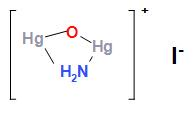Question
Question: When compound (A) reacts with \(N{a_2}Cr{O_4}\) solution, the colour of the compound formed is _____...
When compound (A) reacts with Na2CrO4 solution, the colour of the compound formed is _______
A. Black
B. Red
C. Yellow
D. White
(A)+NaCl→(B) (white ppt.)
(B)+KI→(C) (green ppt.)
(C)+excessKI→(D)+(E) (colourless solution)
(E)+NH3+KOH→(F)
Solution
The colour of a compound is the physical property of that compound which is caused due to the excitation of electrons, i.e. the compound or chemical absorbs some amount of energy. The colour of the compound which we see is not the actual colour it absorbs. So it is the complementary colour of the actual colour absorbed by the compound. The absorption of energy was first observed in atomic or molecular spectroscopy.
Complete step by step answer:
In the first step Hg2(NO3)2 (compound A) reacts with sodium chloride to form Hg2Cl2 (compound B) which is a white ppt. compound. The balanced chemical reaction is written below:
Hg2(NO3)2+2NaCl→Hg2Cl2↓+2NaNO3
In the second step Hg2Cl2 (compound B) reacts with KI to form Hg2I2 (compound C) which is green ppt. compound. The balanced chemical reaction is written below:
Hg2Cl2+2KI→Hg2I2↓+2KCl
In the third step Hg2I2 (compound C) reacts with excess of KI to form K2[HgI4] which is a soluble complex and is commonly known as Nessler reagent. The solution is colorless. The balanced chemical reaction is written below:
Hg2I2+excess2KI→Hg+K2[HgI4]
In the fourth step K2[HgI4](compound E) also known as Nessler reagent reacts with ammonia and potassium hydroxide to form a brown colour complex. The balanced chemical reaction is written below:
K2[HgI4]+NH3+KOH→ 
The compound A Hg2(NO3)2 reacts with Na2CrO4 which forms Hg2CrO4 a red ppt. compound. The balanced chemical reaction is written below:
Hg2(NO3)2+Na2CrO4→Hg2CrO4
After discussing we can say that the colour of the compound is red.
So, the correct answer is Option B.
Note: Transition metals often form coloured compounds. The reason is that they have one or more unpaired electrons in their d- orbitals and when visible light falls on them the unpaired electrons absorb some amount of energy and get excited from higher energy level to lower energy due to which they show the complementary colour of the actual colour they absorbed.
Compounds which have completely filled or no electron in the d- orbital do not form coloured compounds.
